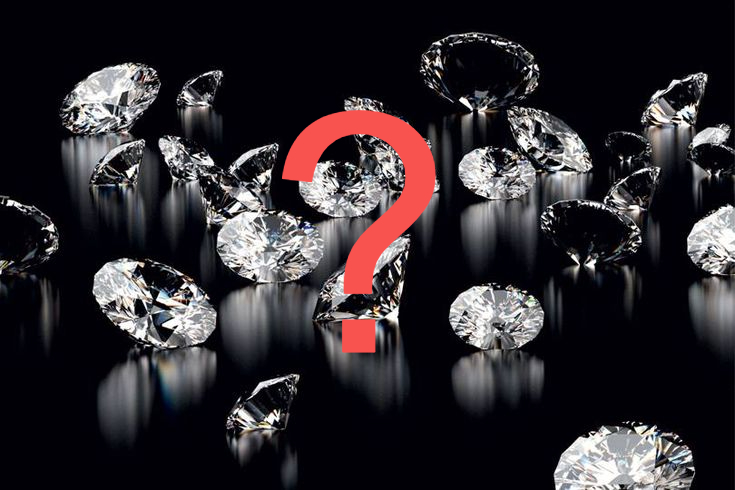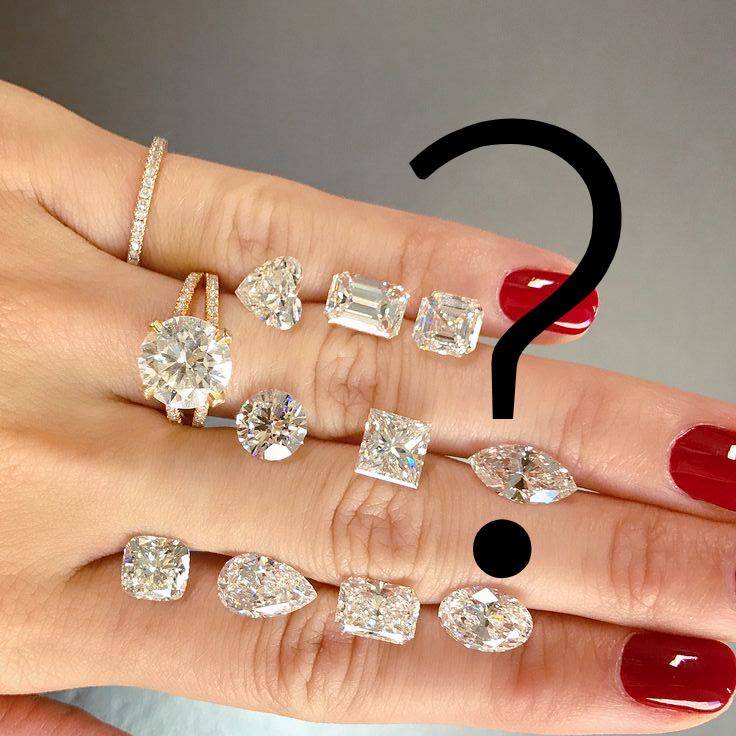- Introduction
- Origin:
- Natural diamonds are formed deep within the earth crust about 1 – 3 billion years ago.
- Natural diamonds are rare and so are considered valuable and very special.
- Lab-grown diamonds are easily made in a laboratory in a matter of weeks
- They are faster processed and are considered less valuable since they can be easily created.
- Effect on the environment
- Natural diamonds are mined and this mining hurts the environment
- Several elements of the ecosystem are displaced during mining. The process of obtaining natural diamonds is not ecofriendly
- Lab-grown diamonds have no negative effect on the ecosystem since all they do is in a laboratory
- Manpower and Equipment:
- Mining requires more manpower and heavy machinery.
- The amount of people needed to work to obtain natural diamonds is almost 10 times more than that required for laboratory-grown diamonds
- Cost:
- The cost of production goes up significantly as a result of the expenses incurred during mining alone.
- Mining would involve several experts and workmen who would be paid to get the diamond
- Laboratory grown diamonds cost less to produce. The process of diamond creation is more cost-efficient with them.
- Price
- As the cost of production increases, you expect a concomitant increase in the price of natural diamonds
- Some prefer this increased price because in a way it limits the number of people that can afford it, creating a class for those who wear it.
- For those that cannot afford to buy a natural diamond, buying a lab-grown diamond is a great alternative
- Popularity
- Natural diamonds have been around for centuries. They are more widely accepted and trusted
- Lab-grown diamonds were introduced about sixty years ago. They have not been widely accepted.
- Value for investment
- Natural diamonds are rare and so more valuable.
- There is a limit to the number of diamonds being produced because it takes a long time to discover and my diamonds
- Laboratories can produce as many diamonds as they want. This means the value of the diamonds would decrease.
- Since it is easier to make lab-grown diamonds, the value is not guaranteed overtime.
- Conflict free diamonds:
- Some natural diamonds are not conflict-free
- Virtually all laboratory-grown diamonds are conflict-free. The resources can easily be traced.
- Conclusion
This debate was inevitable. It was always looming and there is nothing anybody could or can do about it.
This question would always linger on our minds:
Which is better, the laboratory-grown diamonds or the natural diamonds?
This article would compare both diamonds side by side and discuss the strengths and weaknesses of each of them.
Let us delve right in:
Origin:
- Natural diamonds are formed deep within the earth’s crust under extreme heat and pressures. These two factors act on carbon dioxide and then produce the crystal lattice structure that is seen in diamonds today. Natural diamonds were formed about 1 – 3 billion years ago and so are symbolic of longstanding love that would remain over time. The fact that they are also very rare means that they are more unique. It is, therefore, more appreciated when a diamond that is not easily found is given as a gift. There is a lot of value placed on the origin. If a diamond is considered natural, most people consider it more valuable and special because it cannot just be found lying anywhere or grown in some lab! So many people see them as the ‘authentic’ diamonds because even the processes involved in creating the laboratory-grown diamonds try to mimic the process of formation of the natural diamonds!
- Laboratory grown diamonds as implied but their names are cultivated in the laboratory. They are subjected to conditions that mimic the high temperature and high pressures that the natural diamonds were subjected to for a few weeks and a diamond is produced. They are more easily obtained than natural diamonds and therefore not as unique as natural diamonds. They utilize modern technological methods that show a promise for the future of the diamond industry
Effect on the environment
- Natural diamonds are buried deep in rocks, below the earth’s surface. During the mining process, several tons of rocks are exploded. The balance of the ecosystem is severely upset. Diamond companies know these themselves and have tried to take several measures to minimize the effects of this. However, the damage still remains and continues. In these days of climate change, diamond mining remains a major contributor to the depletion of land and the ecosystem.
- Man-made diamonds, on the other hand, do not harm anyone. The environment does not suffer any harm. The processes take place inside a controlled environment in a laboratory. There is no need for explosives or dynamites of any kind. Not one pound of rock is blown apart and if you are not told, you might not know you have a diamond laboratory beside you. Therefore, the process involved in the creation of lab-grown diamonds is more environmental friendly than the mining of natural diamonds.
Manpower and Equipment:
- It is obvious that the mining process of natural diamonds alone would require more manpower. Even before the mining begins several geophysicists, geologists, engineers, surveyors, workmen would have been needed to map out the position of the Kimberlite. Once this is done, several tests would be run to determine the amount of diamond present in the area and to see if it would be economically feasible to begin mining in such a location. When the mining proper begins, a lot of equipment would be needed as explosives are used to blow the rocks apart- trucks, lorries, drivers, cranes, hydraulic shovels and a host of other heavy machinery would be needed. The whole mining process of natural diamonds can be very complex and requires a lot of experts
- The creation of diamonds in the laboratory is a more straightforward process that requires less heavy machinery and workforce. The diamond seed is needed and the machines that create the environment that would allow the diamond to grow. Experts in the field would be needed, but the number is drastically reduced. The number of workers used in the creation process of diamonds can be about 10 times or lesser than the number of workers that are used in mining natural diamonds. The reduced manpower also means faster and more efficient methods of obtaining the diamonds.
Cost:
- From the ongoing discussion, it’s easy to deduce that a natural diamond would definitely cost more to obtain than a laboratory-grown diamond. As we said, even before mining begins, an area suspected to have some Kimberlite deposition has to be tested to see if the area is economically feasible for commercial production of diamonds. Money is being spent even before they are sure that there are diamonds present. Research has also shown that it would take decades of searching for a mining site for diamonds before they are found. This shoots up the cost of production and it is therefore not a very cost-efficient venture compared to the laboratory-grown diamonds
- Laboratory grown diamonds are cost-efficient. The diamond company knows what they want and they create it. There is no need for scouting or trial and error. Since they do not also need mining, they would not need all the heavy machinery and manpower that comes with it. Therefore, there is a reduced cost of operation. Even though the money would be spent on buying equipment needed to create the environment needed for growing the diamond, it is still more efficient when compared to mining.
Price:
- Of course, natural diamonds would cost more! From their discovery to their mining and polishing, money is spent on the high side Therefore, it is only reasonable to expect that the price of a natural diamond would be higher than a laboratory-grown diamond. On the one hand, this means that so many people would not be able to afford the, because of their high prices. But on the other hand, some people from the higher social class would refer to go for it because they believe it is more valuable and shows more class than buying a diamond that seemingly everybody can afford. It would be more appealing to them as a symbol of respect and status
- Laboratory grown diamonds can be purchased at a price that is almost half that of natural diamonds and as the industry has more laboratory manufacturing, the prices would drop. This means that several people that are not super-rich or belong to the higher social class would be able to afford a diamond of their own. They also can wear diamonds without feeling inferior or less because they are also wearing diamonds! Therefore, the laboratory-grown diamonds have found a huge market among people of the middle and lower social classes.
Popularity:
- Natural diamonds on the market. Simple. They own over 90% of the total market and are more accepted and marketable. While the laboratory-grown diamonds are a recent invention, natural diamonds have been around for centuries. They have been used to express love, value, and honor for thousands of years and are therefore more prominent and trusted. Even among our celebrities today, most of them go about wearing natural diamonds. Almost every celebrity marriage or engagement has been sealed with a natural diamond ring and nothing else. The natural diamonds set the pace
- Man-made diamonds were only introduced about sixty years ago and so they are relatively new on the stage. They own just about 2% which is very behind when compared to the natural diamonds. They have not been able to secure the trust of rich and influential people. Most celebrities still prefer natural diamonds and would not want to be associated with lab-grown diamonds. Even though the lab-grown diamond is growing at an impressive rate, a large percentage of the public is set to accept lab-grown diamonds as diamonds. They still see them as some form of alteration of natural processes that can never match the natural diamonds.
Value for Investment:
- Some people keep diamonds, not for love or status alone, but for the investment option it carries. Natural diamonds are rare and as such are very valuable. Some investors would, therefore, consider investing in natural diamonds since those diamonds would retain their value and even appreciate over a period of time. The reason for this is that natural diamonds are rare and so they hold their value. The process of discovery and mining is very difficult and not something that is spontaneously done. It can take decades and so this ensures that there is a limited supply of natural diamonds and s the value is preserved
- Laboratory diamonds are not as valuable as natural diamonds. They can easily be created in a laboratory. They also have prices that fluctuate. It has been projected that the prices of man-made diamonds would fall as more laboratories begin to produce diamonds. Therefore, it is not advisable to buy laboratory-grown diamonds as a mode of investment because their value is not as fixed as the natural diamonds.
Conflict free:
- Natural diamonds have been implicated in drug businesses, child labor, women slavery, and the likes. This is because sometimes, the origin of the mined diamond is difficult to trace, therefore, anyone can just produce a diamond and sell it without giving adequate information about its origins. While this has reduced drastically over the years, there are still conflict diamonds in circulation and it is up to you and your jeweler to ensure that your diamonds are conflict-free.
- Laboratory run diamonds have no conflict problem. The source of the diamond can be easily traced to the labor where it was grown. Simple. So with man-made diamonds, you are 100% sure that you are burning a conflict-free diamond. This is definitely good for your conscience, your soul and your relationship! After all, a diamond is supposed to symbolize love, affection, and value.
In conclusion, laboratory-grown diamonds are here to stay and only the future would tell if it would be able to grow and have a major stake in the industry


